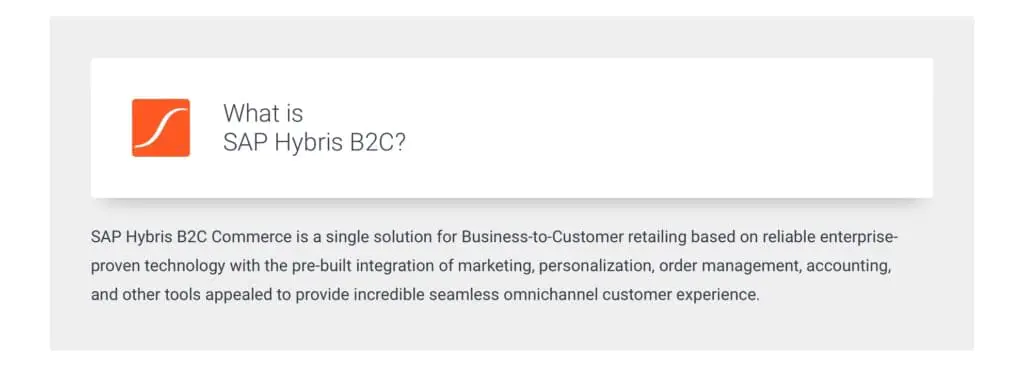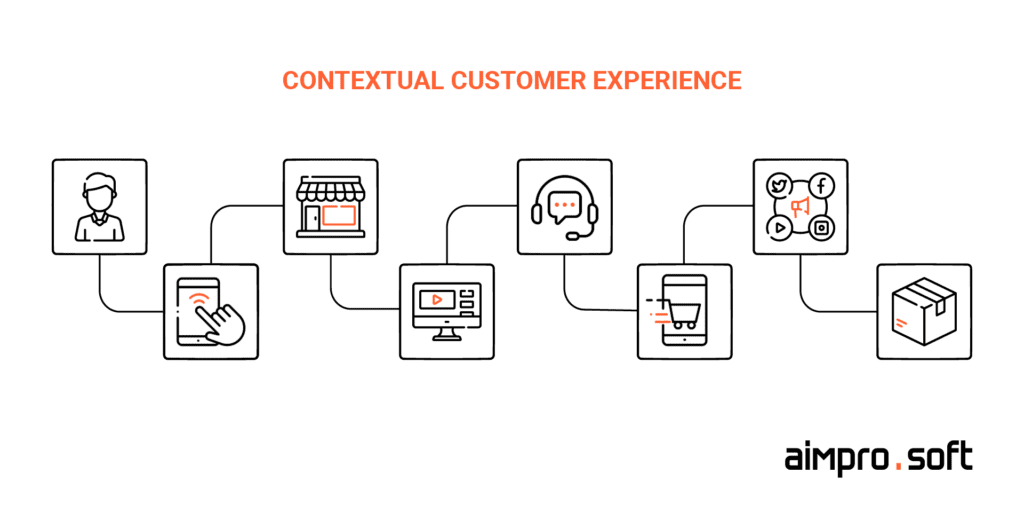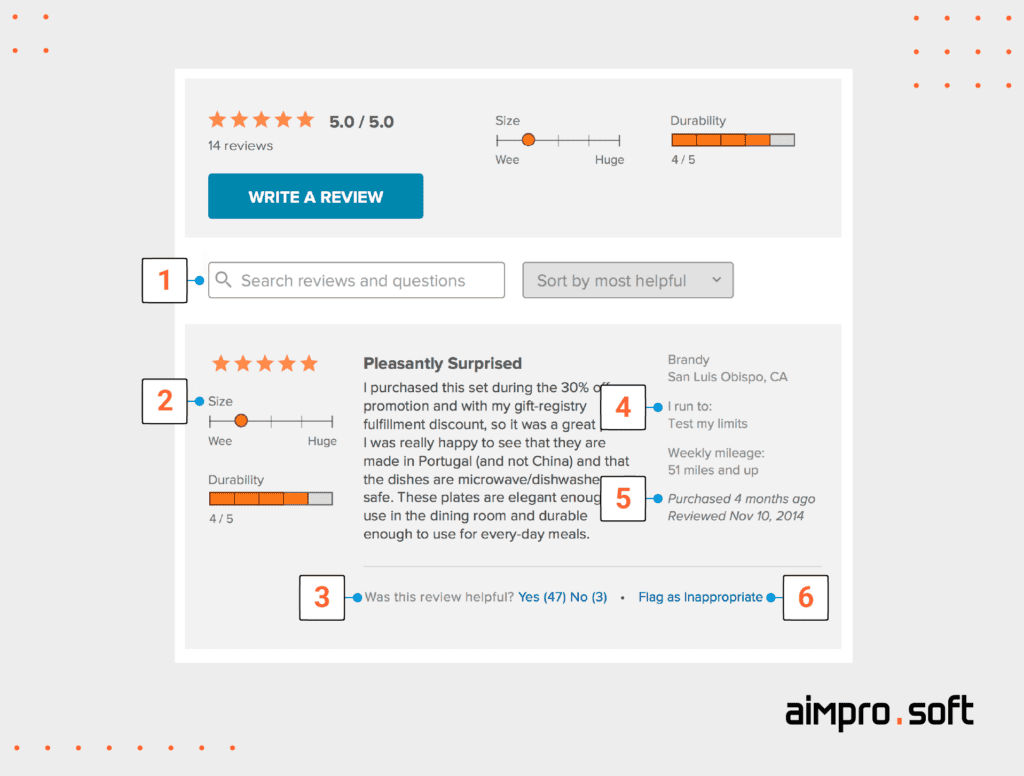SAP Commerce Cloud (Hybris) for B2C eCommerce
Key takeaways
- Know why SAP Hybris B2C Commerce is the choice of retailers in 2022.
- Discover features and challenges for SAP Hybris online stores.
- Read more about why Hybris holds a leading position among e-commerce platforms.
Modern retailers are spoilt for choice when it comes to opting for B2C solutions. This may surprise you, but not every declared leader is in a position to provide a holistic approach both in the user interface and operational backend.
It’s not a secret that everyone longs for special care for their personality. People expect to be pleased and satisfied when coming to the shop or going to the website (or even opening a browser). From way back, shopping has been and remains one of the most enjoyable things in life. The lack of individual shopping treatment to end consumers can cause the apparent attitude of passivity and the risk of losing revenue. Such circumstances result from the not adequately elaborated product destination of a software vendor.
How do you tell apart reliable software producers from imitators? Why is SAP Hybris B2C Commerce considered a leader in its segment? Isn’t it just a bait and switch? We would like to set forth our views on the subject.
What is SAP Hybris B2C?
Initially, SAP Hybris focused on enterprise-level businesses with a wide distribution network of affiliates. After a while, it broadened its offering from scaling large-scaled B2B to B2C companies of medium size, combining them into a B2B2C platform. Thus, companies that grew a small size and for which enterprise is coming up fast got the suite of tools to make a positive shift in their evolution. Well, what is SAP Hybris for B2C?

Let’s figure out all what SAP B2C is capable of and what challenges it copes with.
Challenges and features
You may agree that our contemporaries are highly connected, well-informed, and socialized more than even twenty years ago. Today it became normal to ask for a tip or recommendation from unfamiliar people about things that matter to us. The behavior of every single man has changed. As a result, new challenges related to increased demands to the perfect fulfillment of promises in trading followed.
What are the difficulties B2C companies encounter with the process of amusing their customers? Let’s sort it out.
OMNICHANNEL BUSINESS MODEL
Apart from a multichannel style of sales with the diversity of sales channels like old-school shops and kiosks, fast-growing distribution via social networks (Facebook, Instagram), and more friendly e-Commerce websites, an omnichannel model is a coherent approach to building relationships between companies and people. Here we do not speak about a one-time purchase; it comes to a long-term perspective that stands in need of a single platform with all integrated channels.
Hybris B2C Commerce attains the goals in a very amazing way. What you need is to include data on purchases into the existing ERP system (or use SAP ECC, which is integrated with Hybris naturally) for Hybris can use it to analyze and prepare special offers automatically. Offline sales have to be entered into the database manually. That is to say, data collection from all sales channels is used to create user group flows to form special offers. And indeed, how can we fail to recall Hybris the ability of Hybris to support stocks and warehouses.
CUSTOMIZATION
SAP Commerce would not exist without a customization opportunity with the dataset for defining a target user group named Customization Library. The drag-and-drop management of web pages, layouts, and other components is carried out in the well-established up-to-date CMS Cockpit. A newcomer SmartEdit addon to the existing Hybris WCMS streamlines the personalization of content across all channels in the most intuitive way and provides in-context editing. There are personalization rules configurable for customers. For example, a carousel of items on the homepage will show products based on consumer preferences on his earlier purchases to trigger desirable purchases.
CUSTOMER EXPERIENCE
Contextual customer experience became valuable. Accompanying the customer at every touchpoint of his purchasing journey succeeds in a far-reaching relationship with him. Acting on the spot is essential. SAP Hybris Commerce for B2C helps achieve superior service due to marshaling a buying process. Your specialist on marketing strategy paired with your Hybris development team can design behavioral models imitating factual customer behavior based on key factors of the shopping process: what, where, how, when, how much, etc.

Belgium chocolatier GODIVA with over 90-years of brand history, was short of shutting its online store. Instead, they made a try to expand personal experience contextually, which their customers get at the brick-and-mortar shopping points. The redesign of B2C GODIVA’s website awarded the brand 24% of site-wide conversion, 16% of sales increase, and growth of tablet conversions by 28%, as reported Brita Turner, the Director of e-Commerce at GODIVA.
People are gone to the extent that they identify themselves and their kinds on the basis of goods possessed by them. At the same time, consumers may not remember the products or services the brand offers, but they do remember the experience they had with them and the feeling they were overcome by. That would mean that a particular e-Commerce platform accomplished its task in the right place at the right time.
INTERNATIONAL EXPANSION
We’d venture a guess that when you have a well-functioning local business or even an affiliated distributed network of representative offices across your country, the next significant shift is supposed to be an international market. Opening new sales outlets, country branding of the online store, and integrating appropriate third parties (payment, tax, shipping providers) require a tremendous effort and implies huge investment risks.
SAP B2C solutions are designed for running multiple online stores on one Hybris instance at which no additional license fee is required. It is possible to pull it all together with one thread — online and offline commerce, international customer service, single-out catalogs, product lines, prices and margin, and so on.
CENTRALIZED CONTENT MANAGEMENT
It will save you a lot of headaches down the line while international expansion mostly, but it still matters for national distribution as well to have all data and product content management consolidated on one platform. It’s about product catalogs, price lists, visual, audio, and video content, and user-generated content (reviews, feedback, FAQ, etc.).
WEB CONTENT MANAGEMENT SYSTEM
If you’re serious about bringing in a rush of new customers to your e-store and tempting them to return for repeat purchasing, in addition to online marketing activities is vital to use something else. While in offline commerce, pro bono offers will bear fruit in the long run, and customers will be about to reciprocate the favor, e-Commerce is forced to resort to more inventive techniques.
Hybris solves this issue by means of CMS capabilities. For example, multi- and microsite implementations supported by Hybris WCMS allow moving onto a path of self-reliant feature extension of the online store. That means a vast variety of page templates and content components are come-at-able for updating and creating new web pages. Updates in a content catalog are performed with a version control option in a mode invisible to website users.

B2C retailers of enterprise-level keeping content quality high need to get more ratings and reviews as well as deliver fast answers to customer questions on the spot. It happened that the SAP Hybris B2C platform still has no integration with TurnTo UGC provider for e-Commerce on default. But Hybris developers from Aimprosoft can develop a custom TurnTo addon on-demand to improve shopper-to-shopper communication and level up loyalty to the brand.
ORDER MANAGEMENT
Admit it, when you hear “orchestra,” a band performing ensemble music comes to your mind. In the case of e-Commerce, the relevance to its concept means the pattern of enterprise operation arrangement. Levi’s, for example, has a single informational channel about demands, stock reserve, and arrivals. A shoe retailer Aldo Group had tackled inventory inaccuracy before connecting tried-and-true SAP Hybris Commerce. You must agree that managing global stock visibility across over 2 100 points of sale is challenging.
The Order Management solution embraces distribution channels and logistics providers to ensure coordination of endless aisle programs, which retailers highly esteem. Integration of supply, delivery, stock, and order management data in one centralized location allows having inventory updated in real-time and ensures sales staff that every order will be fulfilled. The system is engaged actively in reducing cart abandonment, price optimization, shipping costs, and store markdowns. Moreover, SAP Commerce Cloud for B2C displays an uprise in communication with clients. Both virtual merchandising and dropshipping do not reveal tracking goods from customers. So it is critical to keep under control updates about order status and notify them timely.
We covered best practices and shared our vision on SAP Hybris for wholesale distribution.
SEAMLESS DATA INTEGRATION
To gather all SAP Commerce options governed by one mediator is no easy feat. In making a data communication, the mediator is one of the most powerful means of connecting Hybris Backoffice solutions within the confines of your business occupation.
In the context of solutions based on Hybris, a client gets not only the online store but scores with a range of e-store management tools. They are e-Commerce, marketing, sales, accounting, ERP, supply and delivery, shipment, support service, and similar. Mentioned SAP Hybris Backoffice solutions are rallied with Data Hub.
It is pretty easy to get integrated the Hybris e-Commerce platform and the diversity of sources with a highly customized Data Hub. In case of SAP ECC, Data Hub is out of the box and requires a competent adjustment only. The question is in cost. It is not surprising that acquiring developers competent in customizing and adjusting Data Hub is higher than the average price but justified. Our clients told us they usually look for the development resources for quite a long time because of the limited number of such specialists in the market. SAP Hybris developers have to be skilled in a firm understanding of Data Hub working principles (how to convert XML files to ImpEx extension and vice versa), strong Hybris ImpEx experience, and adequate knowledge of XSLT.
TOUCH AND DELIVER
We have got clear about the most important things related to SAP Hybris Commerce’s mission for B2C. Last but not least, we are going to reveal a touch and deliver principle after all. Imagine you log in to the backoffice, make the desired changes, click preview to see if everything is fine with you, then sync, and all alterations will be shown on the website. It is immensely convenient to use.
An automated schedule for price changes is available here to tune pricing strategies fast and flexibly. Being close to a hot season or planning bundling offers to move unsold items, you can set up new prices beforehand, and they will be automatically displayed in time. In this respect, a powerful task planner makes applying marketing strategies easier without wasting time on overmanagement.
To learn how Hybris can benefit your business in the raw of the variety of retail platforms deserving attention, keep on reading.
5 reasons why Hybris is a leader in B2C commerce
As much as retailers might wish it, in any case, consumers pave the way. While the former are concerned about getting developed online stores with basic commerce capabilities (catalog, shopping cart, transaction handling, order status, promotions), the latter expect Buy Online Pick Up in Store possibility with gripping purchase journeys based on several touch points.
We went through all salient capabilities of the platform, which stand Hybris out as a leader, just to name a few.
OMNICHANNEL ONLINE AND OFFLINE ENGAGEMENT
The alliance of these two engagement directions requires B2C software vendors to provide the ability to handle sales and payments coming from brick-and-mortar stores and web channels. According to statistics, 1.66 billion global digital buyers were fixed in 2017. But also, some prefer to buy in an old-fashioned way. Is 2018 about flux variation between online and offline purchasing? Well, whatever happened, a holistic platform is the real deal when it comes to driving in-store and online sales.
DIGITAL CUSTOMER EXPERIENCE PERSONALIZATION
Offline shops have become attuned to consumer shopping behavior using face recognition and unique identifiers in smartphones which read the information by beacons and via WiFi. What should undertake online stores? There is a large quantity of CMS components, meta tags and redirections, and a king of frontend — responsive design. In the case of B2C, SAP Hybris Commerce is equipped with tools adjusted in HMC, Backoffice, or CMS Cockpit to ensure personalized experiences for customers in digital commerce. Moreover, WCMS contains exclusive capabilities to make personalization happen across channels and the option of Advanced Personalization to display content related to customer groups.
DATA-DRIVEN MERCHANDISING
It starts with rising expectations of customers (attention to their own personas, demographics, cross-channel service, chatbots, etc.). Customers are those who are calling the shots in 2018. SAP Hybris Sales Cloud Retail solutions, for example, turn this apparent burden of retailers into amusement with a data-driven merchant toolset.
That’s no news yet; an online-first global retailer Amazon goes offline, opening in-store groceries. Why doesn’t Hybris start treating B2C companies and offer technological tools for reporting, analytics, and decisions on the basis of more up-to-date data combining two channels? So it did. Merchandisers can monitor, measure, and benchmark sales performance, not limiting themselves to creating service tickets, follow-up files, generating quotes, etc. All these data will be transferred into the integrated management system instantly.
Of course, SAP Hybris Sales Suite merits a review in its own right, which we will certainly do shortly.
ACCELERATED TIME TO MARKET
The last word-of-mouth trend in e-Commerce is microservices and cloud. Leading B2C platforms have responded to market demands with a platform-as-a-service (PaaS) model. They offer the management of a single-tenant cloud instance and multitenant environment management. Cloud computing technology and service orientation approach help accelerate time to market for retailers who tend to complement their successful offline efforts with an online sales channel. The commerce suite of Hybris implies a fast and agile implementation of the online store no matter what how heavy those solutions are with its YaaS cloud solutions.
Cloud computing is a thing of $300 bln of revenue in B2B and B2C communications. It can serve a purpose for retailers as well.
GDPR COMPLIANCE
Any e-Commerce vendor committed to serving EU retailers (a share of which is 22—23% of world GDP (Gross Domestic Product)has to comply with European Union regulations and legal aspects. If you collect and manage data from EU residents, you have until May 25, 2018, to comply with these new requirements. New regulations draw the attention of software vendors on what data of EU natural persons must be regarded as personal information and is subject to protection in processing by both EU and non-EU organizations.
Follow the guide and checklist to the General Data Protection Regulation.
SAP has four specific features available to assist in ensuring GDPR compliance:
- Process Control (PC) provides ongoing digital evidence to the authority on private data usage.
- Information Lifecycle Management (ILM) and PowerDesigner (PD) are about to tag personal data across multiple environments. ILM is an SAP-only tool and can manage data deleting. PD is non-SAP and covers not deleting data management.
- Information Steward tracks the location of personal data across SAP and non-SAP systems with a focus on accuracy and consistency.
- BI for Cockpit (embedded) is intended for keeping the single place contained real-time GDPR compliance status.
SAP Hybris Marketing Cloud uses an internationally recognized standard ISO/IEC 27001:2013 to ensure intelligent data processing.
How does SAP Hybris B2C Commerce contribute to your business growth?
In 2017 SAP Hybris was recognized as a leader in B2C commerce by Forrester because of the following reasons:
- Focus on B2C Commerce with an all-in-one suite approach;
- Standalone B2C commerce suite with complementary best-of-breed capabilities;
- Annual $20 million revenue from product sales;
- Has over 50 existing clients with the potential for growth;
- Covers B2B market segment offering extended features;
- Provides B2B, B2C, and B2B2C business models.
Of course, there is no full list of options worth taking. We try to make single breakdowns of the SAP Hybris system in our blog to reveal its potential based on our experience. Apart from this, summarizing the current research, we would like to mention the availability to provide an experience management toolset, omnichannel interaction across the digital store and offline outlets, full-spectrum selling, channel management, and eProcurement features more desirable by B2B companies but available out of the box in SAP Hybris Commerce Suite.
Read also our article about SAP Commerce Cloud (Hybris) for B2B eCommerce.
The points described in this article complement a growing amount of helpful tech-savvy content on SAP Hybris Commerce solutions that have already appeared in the Aimprosoft blog.
We at Aimprosoft prepared the guide to the General Data Protection Regulation to spell out what we undertook as a software provider to perform in compliance with the GDPR.
Frequently Asked Questions
Does Hybris support a user-generated content feature?
Initially focused on B2B, Hybris had no in-built user-generated content (UGC) feature to level up loyalty to the brand. However, developers from Aimprosoft created a custom integration tool to connect to the TurnTo platform. Large B2C enterprises can keep content quality at a high level and improve customer communication by answering their questions and reviewing reactions.
How does SAP Hybris simplify my B2C eCommerce business?
SAP Hybris (Commerce Cloud now) simplifies the buying process with a complex of guided selling tools. Businesses benefit from an automated eCommerce solution, be it a chatbot, AI-powered merchandising, or a digital assistant. Starting with search, the customers are accompanied by intuitively designed solutions resulting in a successful buying experience for both process participants.
Can Hybris automate purchasing with personalization in real-time?
Yes, Hybris has a context-driven service that analyses dynamic customer segments based on behavior information. The solution segments customers depending on their buying preferences and personal information. It has a set of defined conditions to classify customers belonging to one of them. It determines products, prices, and personalized offers to show for particular customer groups.
How does Hybris integrate with cloud and SAP suite solutions?
Whether on-premise or cloud-based SAP Commerce (former Hybris), it has a prebuilt integration with the entire line of SAP B2C eCommerce products. All applications are connected seamlessly to provide an omnichannel sales experience. Moreover, SAP Commerce Cloud (formerly SAP Hybris), a B2B and B2C platform, offer an open API for quick integration with 3rd-parties to enhance commerce use cases.
Does SAP Hybris support continuity commerce for B2C?
Continuity programs are one of the best commerce solutions to increase profitability. SAP Commerce B2C solutions provide repeat customer retention based on the best e-commerce practices and analysis, which justifies the acquisition costs over omnichannel touch. It is based on three main factors: recurring revenue, connected devices in customer interaction, and auto-ship functionality.
Is SAP Hybris relevant in 2022?
As stated in the recent report, SAP Commerce Cloud stores show stable growth year-over-year with 11% in 2022 Q1, which means an inexhaustible demand for reliable eCommerce solutions of high level. For example, one of the powerful tools is SAP Customer Data Cloud which identifies customers in the digital environment by collecting, aggregating, and managing customer data across multiple touchpoints and applications.




